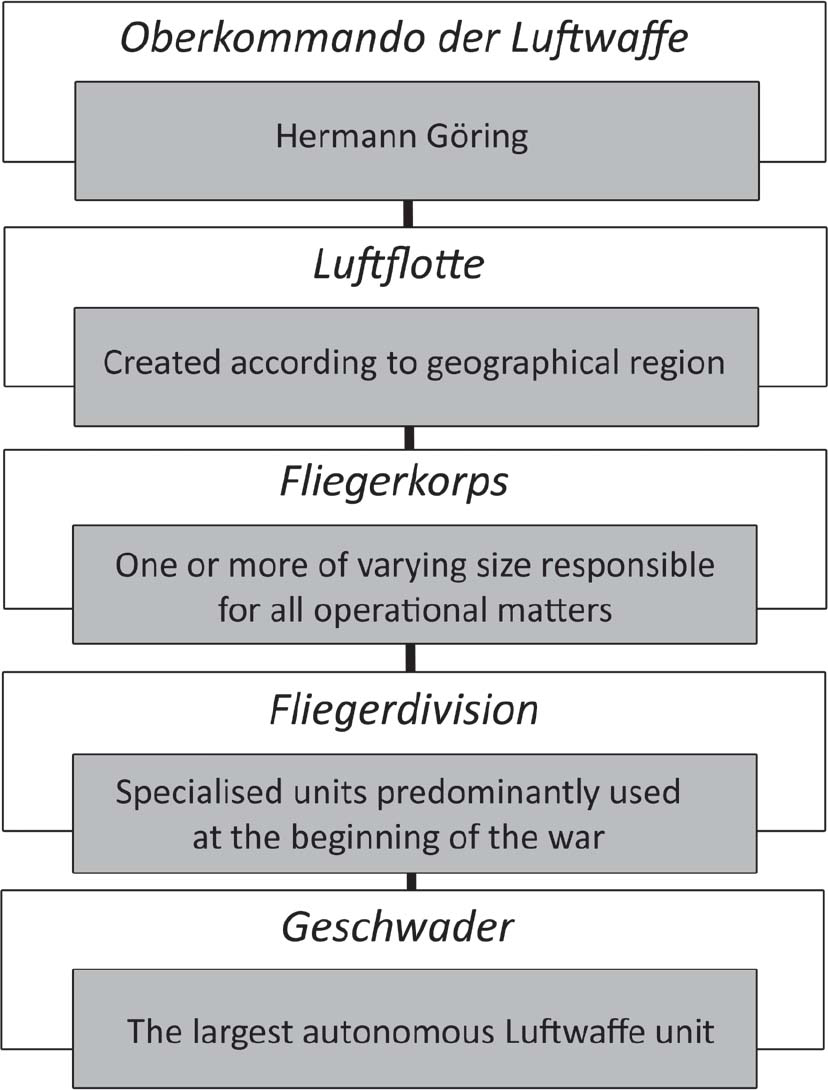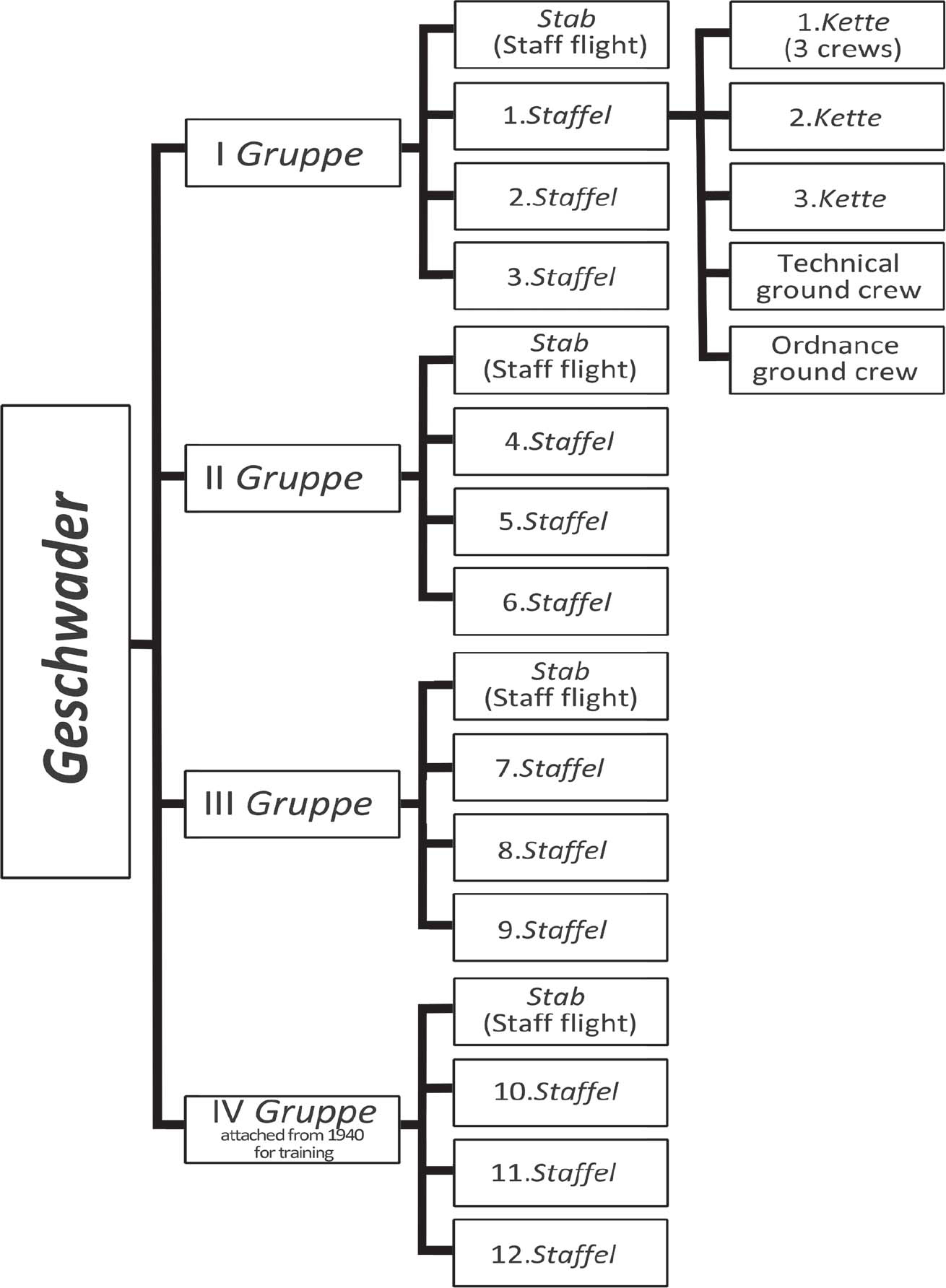
ASW Anti-submarine warfare.
B.d.U. Befehlshaber der U-Boote, Commander-in-Chief, submarines.
B-Dienst Beobachtungsdienst des feindlichen Funkerverkehrs, Kriegsmarine radio monitoring and cryptographic intelligence service.
Bordflieger Shipboard air units, or, alternatively, the pilot of such an aircraft.
OKH Oberkommando des Heeres, Army High Command.
OKL Oberkommando der Luftwaffe, Air Force High Command. Properly established during February 1944, previously designated the Oberbefehlshaber der Luftwaffe (Ob.d.L.: C-in-C Luftwaffe).
OKM Oberkommando der Kriegsmarine, Naval High Command.
OKW Oberkommando der Wehrmacht, Armed Forces High Command.
Fliegerdivison Early-war subdivision of a Fliegerkorps. Kept in use for certain specialised formation.
Fliegerführer Theatre air commander, e.g. Fliegerführer Atlantik.
Fliegerkorps Largest operational level subdivision of Luftflotte. Numbered consecutively with Roman Numerals, e.g. IX.Fliegerkorps.
F.d.Luft Führer der Seeluftstreitkräfte, Commander of maritime combat aviation.
F.d.U Führer der U-boote, early-war designation for Commander submarines.
Geschwader Luftwaffe equivalent to an RAF Group or a USAAF Wing.
Gruppe Luftwaffe equivalent to an RAF Wing or a USAAF Group (plural Gruppen)
Kampfgruppe Independent bomber formation of Gruppe size.
Kette Flight of three aircraft.
Kommandeur Commander of a unit, particularly in Luftwaffe use for Gruppe commander.
Kommodore In the Luftwaffe a Geschwader commander, not an actual rank.
Küstenflieger Luftwaffe equivalent to the Fleet Air Arm.
Luftwaffe German Air Force from 1935 onwards. The term ‘operational Luftwaffe’ is used here to separate orthodox Luftwaffe units from the Küstenflieger and other naval flying units.
Luftflotte Luftwaffe Air Fleet equivalent to an American numbered Air Force. Numbered consecutively with Arabic numerals, e.g. Luftflotte 4.
Luftmine Air-dropped mine.
Kriegsmarine German Navy between 1935 and 1945.
Marinegruppen-kommando Regional command of Kriegsmarine security forces such as minesweeping, submarine hunters, patrol boats and so on, e.g. Marinegruppen- kommando West. Abbreviated to ‘MGK’.
Oberbefehlshaber Commander-in-Chief, Luftwaffe, the military post
der Luftwaffe held by Hermann Göring.
Reichsmarine Pre-war German Navy, renamed Kriegsmarine in 1935.
RLM Reichsluftfahrtministerium, Reich Air Ministry; civilian office headed by Hermann Göring.
Staffel Roughly the Luftwaffe equivalent to an Allied Squadron (plural Staffeln)
Staffelkapitän Squadron Commander, abbreviated to ‘Staka’.
Equivalent Rank Table
| Luftwaffe | Kriegsmarine | Royal Air Force/ US Army Air Force |
| Generalfeldmarschall (GFM) | Grossadmiral | Marshal of the Air Force/General of the Army |
| Generaloberst (Genobst) | Generaladmiral | Air Chief Marshal/ General |
| General der Flieger (Gen.der Flg) | Admiral | Air Marshal/ Lieutenant General |
| Generalleutnant (Genlt) | Konteradmiral | Air Vice-Marshal/ Major General |
| Generalmajor (Genmaj.) | Vizeadmiral | Air Commodore/ Brigadier General |
| Oberst (Obst.) | Kapitän zur See | Group Captain/ Colonel |
| Oberstleutnant (Obstlt.) | Fregattenkapitän | Wing Commander/ Lieutenant Colonel |
| Major (Maj.) | Korvettenkapitän (K.K.) | Squadron Leader/ Major |
| Hauptmann (Hptm.) | Kapitänleutnant (Kaptlt.) | Flight Lieutenant/ Captain |
| Oberleutnant (Oblt.) | Oberleutnant zur See (Oblt.z.S) | Flying Officer/First Lieutenant |
| Leutnant (Lt.) | Leutnant zur See (Lt.z.S.) | Pilot Officer/Second Lieutenant |
| Stabsfeldwebel (Stabsfw.) | Stabsoberfeldwebel | Warrant Officer/ Master Sergeant |
| Oberfeldwebel (Obfw.) | Stabsfeldwebel | Flight Sergeant/ Technical Sergeant |
| Feldwebel (Fw.) | Feldwebel | Sergeant/Staff Sergeant |
| Fähnrich (Fhr.) | Fänrich zur See | Officer Cadet/Flight Cadet |
| Unterfeldwebel (Ufw.) | Obermaat | Corporal/Sergeant |
| Unteroffizier (Uffz.) | Maat | Corporal/Corporal |
| Hauptgefreiter (Hptgfre.) | Matrosenhauptgefreiter | Senior Aircraftman/ Private First Class |
| Obergefreiter (Ogfre.) | Matrosenobergefreiter | Leading Aircraftman/Private First Class |
| Gefreiter (Gfr.) | Matrosengefreiter | Aircraftman 1st Class/Private First Class |
| Flieger (Flg.) | Matrose | Aircraftman 2nd Class/Private |
Luftwaffe Operational Organisation

Tactical Level Luftwaffe Organisational Notes
Though local circumstances could dictate modification to existing unit structure, the general form of a Luftwaffe Geschwader was as follows:

Geschwader: The largest homogeneous Luftwaffe flying unit roughly the equivalent of an RAF Group or a USAAF Wing. Comprising three ‘Gruppen’, the Geschwader was named according to its purpose and its individual identity suffixed by Arabic numerals, such as KG 26. Amongst the most common identification prefixes within this work are:
Fighters: JG (Jagdgeschwader), day fighter single-engine aircraft such as the Bf 109.
Heavy Fighters: ZG (Zerstörergeschwader), day fighter twin-engine aircraft such as the Bf 110.
Bombers: KG (Kampfgeschwader), heavy or medium bombers such as the He 111.
Dive-bombers: StG (Sturzkampfgeschwader), typically Ju 87 Stukas during the early years of the war.
Advanced Training: LG (Lehrgeschwader), often each Gruppe of a different aircraft type.
The Geschwader was commanded by a Geschwaderkommodore, typically of rank between Oberstleutnant or Major. He would have a small staff and a Stabschwarm (staff flight) of perhaps four aircraft, including one belonging to the Geschwaderkommodore.
Gruppe: The basic autonomous Luftwaffe flying unit, roughly equivalent to an RAF Wing or a USAAF Group. Typically comprising a Stabschwarm (staff flight) and three Staffeln commanded by a Gruppenkommandeur, who could be a Major or Hauptmann. He would have a small staff including administration, operations, medical and technical officers. Each Gruppe was identified with a roman numeral (e.g. II.Gruppe of 26th Bomber Geschwader would be II./KG 26). The exception to this rule were those Gruppen acting in autonomous specialised maritime of reconnaissance roles, such as the Küstenfliegergruppen (coastal maritime aircraft) Aufklärungsgruppen (F) (The ‘F’ designates ‘Fernaufklärungsgruppen’, meaning ‘long-range reconnaissance’), Bordfliegergruppen (aircraft carried aboard surface ships), Seeaufklärungsgruppen (maritime reconnaissance) and Trägergruppen (carrier aircraft), which were designated using Arabic numerals.
Staffel: Roughly the equivalent to an Allied Squadron, comprising from nine to twelve aircraft and commanded by a Staffelkapitän (abbreviated to ‘Staka’) generally of a rank between Hauptmann and Leutnant as the most junior example. The Staffeln were numbered consecutively within the Geschwader with Arabic numerals (e.g. third Staffel of 26th Bomber Geschwader would be 3./KG 26) therefore it would always be possible to identify the first three Staffeln as belonging to I Gruppe, Staffeln 4-6 to II Gruppe, and so on. Each Staffel generally comprised three Ketten of three aircraft each, and associated ground crew.
Luftwaffe aircraft identification codes
Luftwaffe aircraft markings are a multifaceted and intricate subject that involves symbols and colour codes each denoting a unit or position within the command structure. The system evolved continuously until 24 October 1939, when a compact four-character code was introduced. This is simply an introduction to the adopted four-character numbering system used to identify all aircraft, except for Jagdgeschwader, which had a separate complex system and are outside the scope of this study. The code is divided, with an alpha-numeric pair of characters to the left of the Balkankreuz (straight-sided cross) that adorned Luftwaffe aircraft, and two letters to the right. The two letters to the left indicated the parent Geschwader (or Gruppe) to which the aircraft belonged. To the right of the Balkankreuz the numeral, usually colour-coded, was the individual aircraft number, and the letter indicated the Staffel.
Four-digit Staffel letters: Geschwader Stab.: A

You will find frequent mentions of such four-digit codes within the text to identify various aircraft, written thus: M2+SL. In this particular case the letters denote aircraft ‘S’ of 3.Staffel (‘L’) belonging to Küstenfliegergruppe 106 (M2). Below is relevant unit two-digit coding (used from October 1939) for the units mentioned within this book:
1./BFl.Gr. 196: T3
5./BFl.Grp.196: 6W KG 26: 1H
KG 30: 4D
KG 40: F8
KG 54: B3
KG 77: 3Z
KGr. 126: 1T (also used by aircraft of III./KG 26 between January 1942 and February 1943)
Kü.Fl.Gr. 106: M2
Kü.Fl.Gr. 306: K6 (shared with Kü.Fl.Gr. 406, to which it was attached) Kü.Fl.Gr. 406: K6
Kü.Fl.Gr. 506 and KGr. 506: S4 (originally M7) Kü.Fl.Gr. 606 and KGr. 606: 7T (originally 8L) Kü.Fl.Gr. 706: 6I
Kü.Fl.Gr. 806 and KGr.806: M7 Kü.Fl.Gr. 906: 8L
Küstenfliegerstaffel Krim: 6M LG1: L1
Minensuchgruppe der Luftwaffe: 3K (‘Mausi’ aircraft) SAGr. 125: 7R
SAGr. 126: D1
2.Seenotstaffel: N7
3.Seenotstaffel: M6
5.Seenotstaffel: P7
6.Seenotstaffel: K3
7.Seenotstaffel: J9
8.Seenotstaffel: M1
10.Seenotstaffel: 5W
Trägergruppe 186: J9
Transozeanstaffel and KG.z.b.V 108: P5